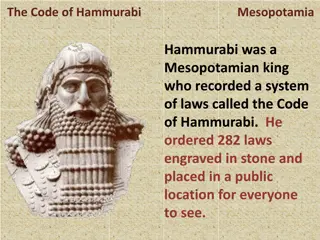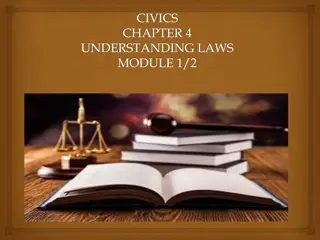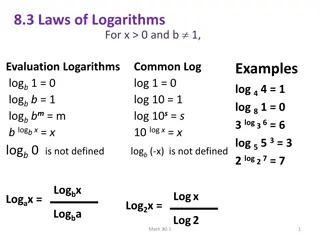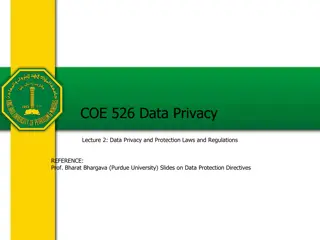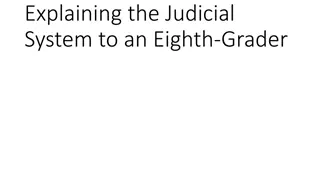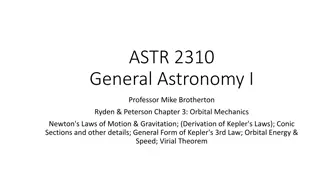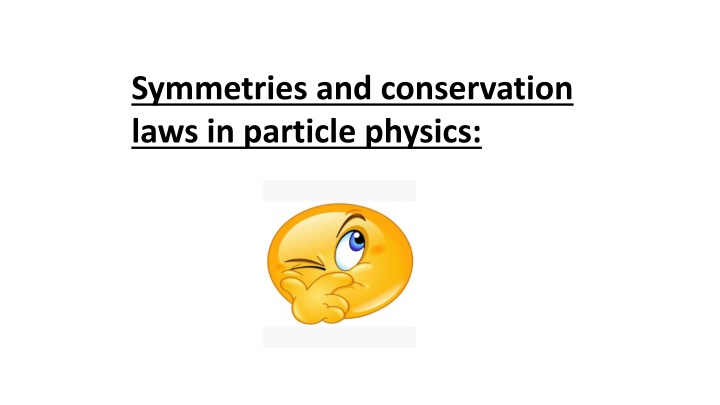
Particle Physics Conservation Laws and Symmetries Overview
Explore the symmetries and conservation laws in particle physics, such as universal and particular conservation laws including energy, momentum, angular momentum, lepton number, baryon number, and more. Learn about the conservation of angular momentum due to rotational symmetry, and the significance of lepton number and baryon number conservation in particle reactions. Dive into the world of isospin and its conservation principles in the domain of strong interactions.
Download Presentation

Please find below an Image/Link to download the presentation.
The content on the website is provided AS IS for your information and personal use only. It may not be sold, licensed, or shared on other websites without obtaining consent from the author. If you encounter any issues during the download, it is possible that the publisher has removed the file from their server.
You are allowed to download the files provided on this website for personal or commercial use, subject to the condition that they are used lawfully. All files are the property of their respective owners.
The content on the website is provided AS IS for your information and personal use only. It may not be sold, licensed, or shared on other websites without obtaining consent from the author.
E N D
Presentation Transcript
Symmetries and conservation laws in particle physics:
Conservation laws in particle physics can be divided into two categories. Universal conservation laws: Holds for all four fundamental interactions. Particular conservation laws: Does not hold in all four fundamental interactions. Conservation laws: Universal: Energy(E). Linear momentum(p). Angular momentum(J). Lepton number(L). Baryon number(B). Charge(Q). CPT. Particular: Isospin(I). Strangeness(S). Hypercharge(Y). Parity(P). Charge conjugation(C). Time reversal(T). CP
In the previous classes, we have already discussed conservation laws of energy, Electric charge and linear momentum. Conservation of angular momentum: Conservation of angular momentum is due to rotational symmetry and is verified by checking conservation of spin angular momentum. Consider the reaction, n ------ p + e- (1) All are fermions here so, spin is not conserved. This is not a valid reaction. But n--- p + e- + e (2) where, e represents, electron anti-neutrino. Now the spin is conserved and hence we say that angular momentum is conserved.
Lepton number and its Conservation : Lepton number is a charge assigned as below: +1 for all leptons, -1 for all anti-leptons and 0 for non leptons. This law states that, in any particle reaction or decay the total number of leptons is always conserved. Illustrations: Consider the following reactions: 1. n ----- p + e- (not allowed.) 2. n ----- p + e- + e (allowed) 3. n ----- p + e- + e (not allowed) 4. + ---- e+ + e + e (allowed) 5. 0 ----- p + - (allowed)
Baryon number and its Conservation : Baryon number is also a charge and assigned as below: +1 for baryons, -1 for anti baryons and all other particles like mesons, leptons and quanta of force carry baryon number equal to zero. This law states that, in any particle reaction or decay the total number of baryons is always conserved. Illustrations: Consider the following reactions: 1. 0 ----- p + - (allowed) 2. 0 ----- p + + ( not allowed) 3. + + n---- K0 +K+ (not allowed)
Isospin and its conservation: Iso means same and hence isospin literally means similar to spin . Neutrons and protons have many similar properties like spin, mass but not charge. But nuclear force is charge independent and electromagnetic force will not affect much on strong interaction between protons and neutrons.(1/137 times weaker than strong interaction.) Therefore in the world of strong interaction, we can think of protons and neutrons as two orthogonal states { different states} of same particle called nucleon . Calculation of I and I3 for different family of particles: Multiplicity , M=2I+1, where I represents isospin. Nucleon family(proton and neutron) : here M=2; 2I+1=2 therefore; I=1/2. The third component of isospin, I3 (represents different orthogonal states or degenerate states in strong interaction) can have the values I to +I in steps of one. Therefore, possible values of I3 for nucleon family is I3 =+1/2 for proton and I3 =-1/2 for neutron. Respective anti particles will have isospin values reversed in sign.
Family, members and multiplicity I I3 Nucleon family: n0 and p+ ;M=2. +1/2 for p+ and -1/2 for n0 1/2 Pion family: +, - and 0 ; M=3. -1 for -, 0 for 0 and +1 for + . 1 K- family: K+ and K0 ; M=2 +1/2 for K+ and -1/2 for K0 1/2 family: + , - and 0 ; M=3. +1 for +,0 for 0 and -1 for - . 1 family: ++ , + , - and 0; M=4 +3/2 for ++ , +1/2 for + , - 1/2 for 0 and -3/2 for - 3/2 family: - and 0 ; M = 2 +1/2 for 0 and -1/2 for - 1/2 0 0 family: - ; M=1 family: 0 ; M=1 0 0
Conservation of isospin: Isospin I is conserved in strong interactions only; not in weak or electromagnetic interactions. The third component of isospin I3 is conserved in strong and electromagnetic interactions but not in weak interactions. Illustrations: Consider the following reactions: 1. P + P ----- 0 + K0 + P + + (allowed) 2. + -------- P + 0 (allowed) 3. 0 --------- P + - (not allowed) 4. 0 ---------- 0 + (not allowed)
Strangeness and Hypercharge: (Gell-Mann Nishijima scheme) Strangeness: We know that baryons are divided into : 1. Nucleons: protons and neutrons. 2. Hyperons: The term hyperons refers to those unstable particles which carry additional quantum number called strangeness to distinguish them from nucleons. The well known hyperons are : i. hyperons. ii. hyperons. iii. hyperons and iv. hyperons. These hyperons are observed to behave in a strange manner as given below: 1. They are produced by strong interaction ( characteristic time of 10-23 s) and decay through weak interactions (characteristic time of 10-8 s). 2. They are always produced in pairs: with following one exception: 0 ---------- 0 + (EM interaction)
Example: P + - ------ 0 + K0 (strong interaction; 10-23 s) Where 0 and K0 decays by weak interaction(10-8 s) as: 0 ----- n + 0 K0 ------ + + - Calculation of strangeness value for hyperons: Strangeness of any hyperon can be calculated from Gell-Mann Nishijima formula which is given by : Q = I3 + Y/2 ------- (1) Where Q is electric charge, I3 is third component of isospin and Y is hypercharge. and Y = B + S where again, B is baryonic number and S is strangeness. Therefore, equation (1) becomes ; Q = I3 + (B + S)/2 ----- (2) From which, the equation for strangeness S becomes; S = 2(Q I3) B ------ (3)
Strangeness of some notable hyperons: Hyperon Q B I I3 S K+ +1 0 1/2 +1/2 +1 K0 0 0 1/2 -1/2 +1 + +1 +1 1 +1 -1 - -1 +1 1 -1 -1 0 0 +1 1 0 -1 - -1 +1 1/2 -1/2 -2 0 0 +1 1/2 +1/2 -2 0 0 +1 0 0 -1 - -1 +1 0 0 -3 Strangeness number is zero for all other particles like nucleons, mesons and leptons.
Conservation of strangeness: Total number of strange particles in a reaction or decay is conserved . One more strangeness about strangeness conservation law is, it holds in strong interaction(i.e., during production) and violated in weak interaction(i.e., during decay). Illustrations: 1.P + - -------- 0 + K0 (allowed) 2.P + - --------- n + K0 (not allowed) 3.P + - -------- 0 + K0 (allowed) 4.n + - -------- - + K0 (allowed)
Hypercharge and its conservation: Hypercharge (Y) is given by : Y = B + S Hypercharge is conserved in strong interactions and EM interactions only. Calculation of hypercharge for different family of particles: Family B S Y = B + S Nucleons +1 0 +1 Sigma[ ] +1 -1 0 Cascade[ ] +1 -2 -1 Kaons [K] 0 1 1 Lambda[ ] +1 -1 0 Omega[ ] +1 -3 -2
Illustrations: 1)P + - -------- 0 + K0 (Allowed) 2)P + - --------- n + K0 (not allowed) 3) + + n---- K0 +K+ (not allowed) 4) 0 ----- p + - ( Not allowed)


